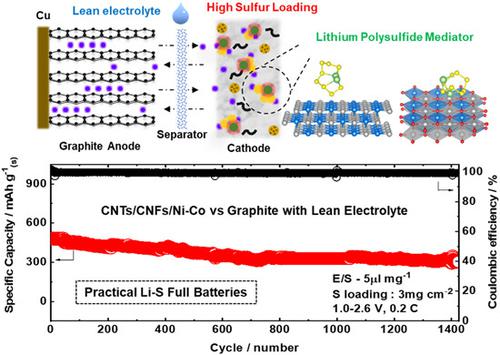当前位置:
X-MOL 学术
›
Carbon Energy
›
论文详情
Our official English website, www.x-mol.net, welcomes your feedback! (Note: you will need to create a separate account there.)
Heterostructured nickel–cobalt metal alloy and metal oxide nanoparticles as a polysulfide mediator for stable lithium–sulfur full batteries with lean electrolyte
Carbon Energy ( IF 20.5 ) Pub Date : 2024-02-15 , DOI: 10.1002/cey2.472 Hyeona Park 1 , Suyeong Lee 2 , Hyerim Kim 1 , Hyunyoung Park 3 , Hun Kim 1 , Jongsoon Kim 3, 4 , Marco Agostini 5 , Yang‐Kook Sun 1, 6 , Jang‐Yeon Hwang 1, 6
Carbon Energy ( IF 20.5 ) Pub Date : 2024-02-15 , DOI: 10.1002/cey2.472 Hyeona Park 1 , Suyeong Lee 2 , Hyerim Kim 1 , Hyunyoung Park 3 , Hun Kim 1 , Jongsoon Kim 3, 4 , Marco Agostini 5 , Yang‐Kook Sun 1, 6 , Jang‐Yeon Hwang 1, 6
Affiliation

|
Batteries that utilize low-cost elemental sulfur and light metallic lithium as electrodes have great potential in achieving high energy density. However, building a lithium–sulfur (Li–S) full battery by controlling the electrolyte volume generally produces low practical energy because of the limited electrochemical Li–S redox. Herein, the high energy/high performance of a Li–S full battery with practical sulfur loading and minimum electrolyte volume is reported. A unique hybrid architecture configured with Ni–Co metal alloy (NiCo) and metal oxide (NiCoO2) nanoparticles heterogeneously anchored in carbon nanotube-embedded self-standing carbon matrix is fabricated as a host for sulfur. This work demonstrates the considerable improvement that the hybrid structure's high conductivity and satisfactory porosity promote the transport of electrons and lithium ions in Li–S batteries. Through experimental and theoretical validations, the function of NiCo and NiCoO2 nanoparticles as an efficient polysulfide mediator is established. These particles afford polysulfide anchoring and catalytic sites for Li–S redox reaction, thus improving the redox conversion reversibility. Even at high sulfur loading, the nanostructured Ni–Co metal alloy and metal oxide enable to have stable cycling performance under lean electrolyte conditions both in half-cell and full-cell batteries using a graphite anode.
更新日期:2024-02-17



























 京公网安备 11010802027423号
京公网安备 11010802027423号